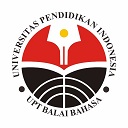EFEKTIVITAS METODE COOPERATIVE LEARNING TIPE INSIDE-OUTSIDE CIRCLE DALAM MENINGKATKAN KEMAMPUAN BERBICARA BAHASA JEPANG (PENELITIAN EKSPERIMEN KUASI TERHADAP SISWA KELAS XII IPA 2 SMA PASUNDAN 2 BANDUNG)
Abstract
Abstrak
Penelitian ini dilatar belakangi oleh kurangnya kesempatan siswa untuk berbicara saat pembelajaran bahasa Jepang. Setengah dari sampel menyatakan bahwa selama ini kurang mendapatkan kesempatan berbicara bahasa Jepang dalam pembelajaran bahasa Jepang. Padahal saat ini siswa dituntut untuk dapat berbicara dan berkomunikasi secara global. Dan kemampuan berbicara adalah implementasi dari materi-materi pelajaran bahasa Jepang yang telah dipelajari. Untuk mengatasi masalah tersebut, peneliti mengujicobakan metode cooperative learning tipe inside-outside circle dalam pembelajaran bahasa Jepang terhadap siswa XII IPA 2 SMA Pasundan 2 Bandung. Tujuan dari dilaksanakannya pembelajaran dengan metode ini adalah agar siswa mampu untuk berbicara dengan bahasa Jepang secara aktif dan menguji efektivitas dari metode tersebut.Penelitian ini menggunakan metode eksperimen kuasi (pre-test and post-test one group). Teknik pengambilan sampling dengan cara random sampling. Populasi dalam penelitian ini adalah seluruh siswa SMA Pasundan 2 Bandung dan sampelnya adalah 16 orang siswa kelas XII IPA 2 sebagai kelas eksperimen. Instrumen dalam penelitian ini adalah tes dan angket.Dari hasil analisa data tes diperoleh nilai t-hitung sebesar 4,205. Dan dengan db 15 pada tahap signifikansi 5% diperoleh t-tabel sebesar 2,13 dan signifikansi 1% diperoleh t-tabel sebesar 2,95. Karena nilai t-hitung > t-tabel , maka Hk diterima. Hal tersebut berarti terdapat perbedaan yang signifikan pada kemampuan berbicara siswa sebelum dan sesudah diterapkannya metode cooperative learning tipe inside-outside circle. Hal tersebut diperkuat dengan hasil angket yang menyatakan bahwa lebih dari setengah responden merasakan pengaruh penerapan metode cooperative learning tipe inside-outside circle terhadap kemampuan berbicara bahasa Jepang.
Keyword: kemampuan berbicara, metode cooperative learning tipe inside-outside circle
Abstract
This research was motivated by the lack of opportunity to speak Japanese during the class. 50% of the sample stated that they are have a small opportunity to speak Japanese during learning Japanese. Yet, in this time students are required to be able to talk and communicate globally. And the ability to speak is the implementation of Japanese language lessons. To overcome these problems, researcher tested the method of cooperative learning type of inside-outside circle in learning the Japanese language to students XII IPA 2 SMA Pasundan 2 Bandung. The purpose of the implementation of learning with this method is the students are able to speak japanese actively and to test the effectiveness of the method. This research uses a quasi experimental (pre-test and post-test one group). Sampling technique by means of random sampling. The population in this study were all high school students of SMA Pasundan 2 Bandung and the sample was 16 students of class XII IPA 2 as the experimental class. Instruments for this research is a test and questionnaire. From the analysis of obtained data, value t-count of 4,205. And with 15 db at this stage of the 5% significance was obtained t-table by 2.13 and 1% significance obtained t-table by 2.95. Because the value of t count> t-table, then Hk accepted. This means that there are significant differences in their speaking ability before and after the implementation of cooperative learning type of inside-outside circle. This is reinforced by the results of a questionnaire which states that more than half of the respondents feel the effect of the application of cooperative learning type of inside-outside circle of the ability to speak Japanese.
Keyword: speaking ability, cooperative learning method type of inside-outside circle
Full Text:
PDFReferences
Arikunto, S. (2010). Prosedur penelitian suatu pendekatan praktik. Jakarta: Rineka Cipta.
Isjoni. (2011). Cooperative learning: Efektivitas pembelajaran kelompok. Bandung: Alfabeta.
Lie, A. (2002). Cooperative learning. Jakarta: PT. Grasindo.
Ogawa, Y. (1982). Nihongo kyouiku jiten. Tokyo: Daiosamu Toshokan.
DOI: https://doi.org/10.17509/japanedu.v1i2.3286
Refbacks
- There are currently no refbacks.
Copyright (c) 2016 JAPANEDU: Jurnal Pendidikan dan Pengajaran Bahasa Jepang

This work is licensed under a Creative Commons Attribution-ShareAlike 4.0 International License.
 Published by:
Published by: Department of Japanese Language Education, Faculty of Language and Literature Education
Universitas Pendidikan Indonesia
 Online ISSN: Online ISSN:2528-5548 |

JAPANEDU: Jurnal Pendidikan dan Pengajaran Bahasa Jepang (e-ISSN:2528-5548) lisenced under a Creative Commons Attribution-ShareAlike 4.0 Internasional (CC BY-SA 4.0)

